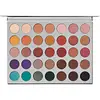What's inside
What's inside
 Key Ingredients
Key Ingredients

 Benefits
Benefits

No benefits
 Concerns
Concerns

 Ingredients Side-by-side
Ingredients Side-by-side

Mica
Cosmetic ColorantSynthetic Fluorphlogopite
Phenyl Trimethicone
Skin ConditioningEthylhexyl Palmitate
EmollientIsononyl Isononanoate
EmollientTridecyl Trimellitate
EmollientMagnesium Myristate
Silica
AbrasiveIsostearyl Isostearate
EmollientNylon-12
Magnesium Stearate
Cosmetic ColorantBoron Nitride
AbsorbentPolyethylene
AbrasiveSimmondsia Chinensis Seed Oil
EmollientCocos Nucifera Oil
MaskingButyrospermum Parkii Butter
Skin ConditioningPhenoxyethanol
PreservativeCaprylyl Glycol
EmollientEthylhexylglycerin
Skin ConditioningTocopheryl Acetate
AntioxidantTin Oxide
AbrasiveIron Oxides
CI 16035
Cosmetic ColorantCI 75470
Cosmetic ColorantCI 77007
Cosmetic ColorantCI 42090
Cosmetic ColorantCI 77891
Cosmetic ColorantRoyal Jelly
Calcium Aluminum Borosilicate
Mica, Synthetic Fluorphlogopite, Phenyl Trimethicone, Ethylhexyl Palmitate, Isononyl Isononanoate, Tridecyl Trimellitate, Magnesium Myristate, Silica, Isostearyl Isostearate, Nylon-12, Magnesium Stearate, Boron Nitride, Polyethylene, Simmondsia Chinensis Seed Oil, Cocos Nucifera Oil, Butyrospermum Parkii Butter, Phenoxyethanol, Caprylyl Glycol, Ethylhexylglycerin, Tocopheryl Acetate, Tin Oxide, Iron Oxides, CI 16035, CI 75470, CI 77007, CI 42090, CI 77891, Royal Jelly, Calcium Aluminum Borosilicate
Ingredients Explained
These ingredients are found in both products.
Ingredients higher up in an ingredient list are typically present in a larger amount.
Caprylyl Glycol is a humectant and emollient, meaning it attracts and preserves moisture.
It is a common ingredient in many products, especially those designed to hydrate skin. The primary benefits are retaining moisture, skin softening, and promoting a healthy skin barrier.
Though Caprylyl Glycol is an alcohol derived from fatty acids, it is not the kind that can dry out skin.
This ingredient is also used as a preservative to extend the life of products. It has slight antimicrobial properties.
Learn more about Caprylyl GlycolCi 75470 is a bright-red pigment. It is AKA carmine.
Carmine is derived from insects such as the cochineal beetle. This ingredient has been used as a natural dye for over 2000 years.
Ci 77891 is a white pigment from Titanium dioxide. It is naturally found in minerals such as rutile and ilmenite.
It's main function is to add a white color to cosmetics. It can also be mixed with other colors to create different shades.
Ci 77891 is commonly found in sunscreens due to its ability to block UV rays.
Learn more about CI 77891Ethylhexyl Palmitate, also known as octyl palmitate, is created from 2-ethylhexyl alcohol and palmitic acid. It is a fatty acid ester.
The fatty acid content of Ethylhexyl Palmitate makes it an emollient. Emollients help soften and hydrate your skin by trapping moisture within.
Ethylhexyl Palmitate is also used to help improve the texture of cosmetics. It helps other ingredient dissolve in products and help disperse ingredients more evenly.
You'll likely find this ingredient in sunscreen, as it is often used to mix UV-blocking ingredients such as avobenzone and ethylhexyl triazone.
It can also help stabilize the fragrances in a product as a fragrance fixative.
Ethylhexyl Palmitate can be used to substitute mineral oil.
Due to its high fatty acid content, it may not be fungal-acne safe.
Learn more about Ethylhexyl PalmitateWe don't have a description for Magnesium Myristate yet.
Mica is a naturally occurring mineral used to add shimmer and color in cosmetics. It can also help improve the texture of a product or give it an opaque, white/silver color.
Serecite is the name for very fine but ragged grains of mica.
This ingredient is often coated with metal oxides like titanium dioxide. Trace amounts of heavy metals may be found in mica, but these metals are not harmful in our personal products.
Mica has been used since prehistoric times throughout the world. Ancient Egyptian, Indian, Greek, Roman, Aztec, and Chinese civilizations have used mica.
Learn more about MicaPhenoxyethanol is a preservative that has germicide, antimicrobial, and aromatic properties. Studies show that phenoxyethanol can prevent microbial growth. By itself, it has a scent that is similar to that of a rose.
It's often used in formulations along with Caprylyl Glycol to preserve the shelf life of products.